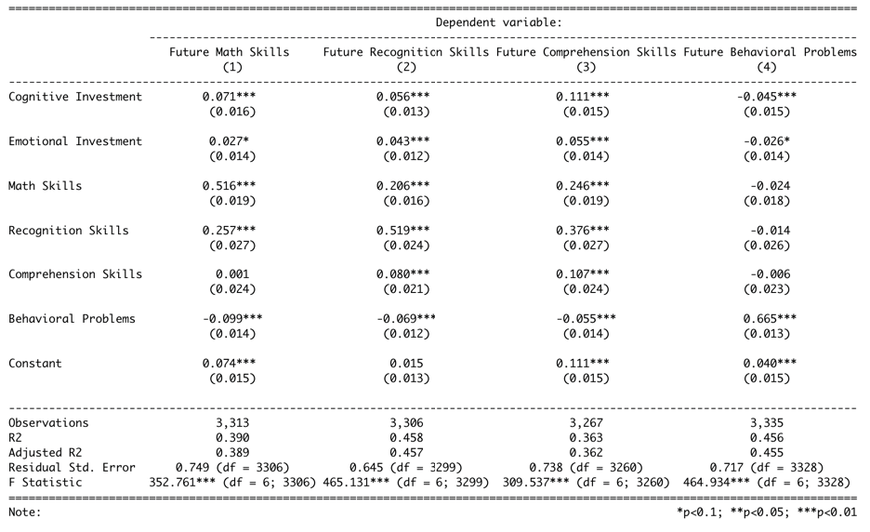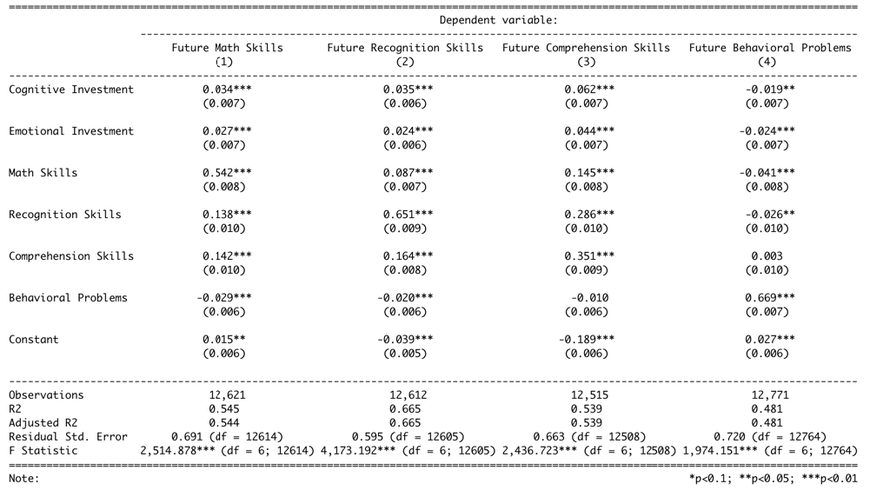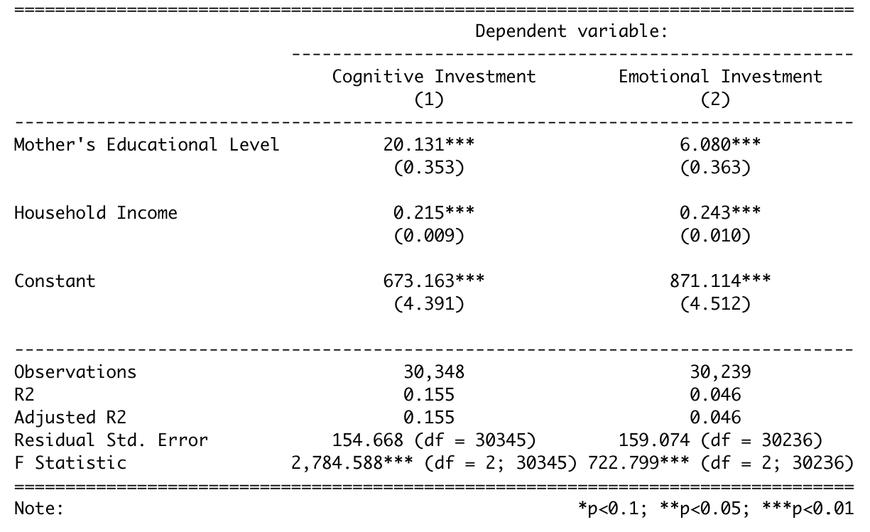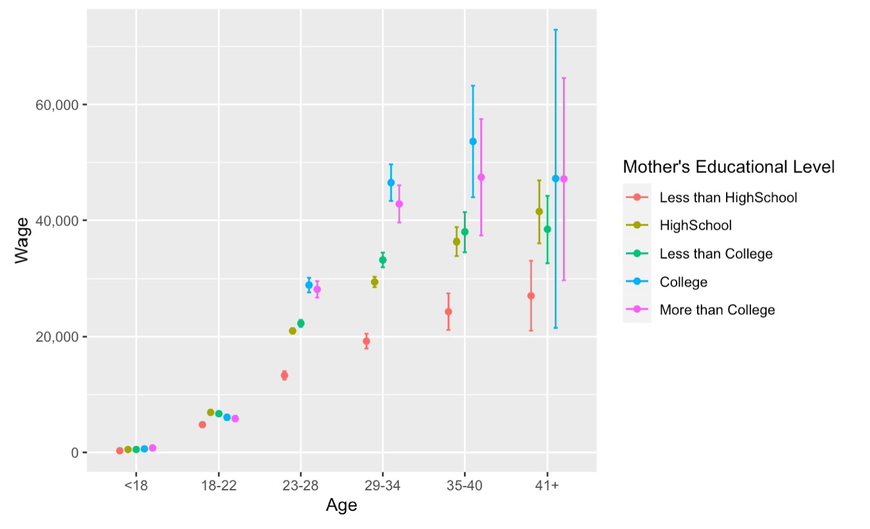Intergenerational Determinants of Inequality in Early Childhood Outcomes
This article is part of a series of research insights written by undergraduate research assistants. Huda Osman is pursuing a Bachelor of Science in economics with a double major in philosophy, and plans to graduate in Fall 2022. She has been working with Professor Joseph Mullins as research assistant in the HHEI Undergrad Research Program for the past year. An Egyptian born and raised in Qatar, Huda plans to pursue a PhD in Economics after graduation.

Does parental investment in a child’s early life affect the child’s future as an adult? In what ways does it affect the child? How would parental investment contribute to a child’s economic well-being? These are all questions we aim to answer by examining the trends of how different parental features affect children’s behavior and future economic success.
We hypothesize that adult outcome and success are a result of parental investment in the child and the economic resources that the family possesses. Our hypothesis can be visualized in the following flowchart:

We collected our data from the National Longitudinal Survey Investigator. Specifically, we focused on the following two cohorts: the National Longitudinal Survey of Youth 1979 (NLSY79) and the NLSY79 Children and Young Adult. The reports from the NLSY79 Children and Young Adult are the reported children of the individuals in the NLSY79. We use this data in order to find trends regarding how parents’ characteristics and behavior affected their children in the long term.
First, we looked at how the individual’s cognitive and non-cognitive skills affect their future income. In order to demonstrate that, we ran a regression of the last wage the individual received on their behavioral problems score and academic scores:

The above results tell us that there is a statistically significant negative correlation between the child’s troubling behavior and their latest wage as an adult. Meanwhile, there is a positive correlation between the child’s cognitive skills and their income. This brings us to our second question: what determines a child’s skill set?
In order to figure out the determinants of the child’s comprehension skills, we ran a regression of child skills on parental investment and lagged child skills. For example, if the parent invested emotionally in their child by spending time with them in 1990, we want to see the effect that would have on the child in 1992, controlling for the child’s stock of skills in 1990. Additionally, we separated the regressions into two age groups: 4-7 years and 8-12 years. Development in early childhood differs from development in early adolescence. Therefore, having two age groups will help give us more accurate results on what the effects are across these life stages.
The following table is the regression ran for the children when they were 4-7 years old:

The following table is the regression ran for the children when they were 8-12 years old:

Something interesting to take notice of here is the change in magnitude in the parental investment and the previous period’s skills. From the ages 4-7 to the ages 8-12, the magnitude of the effect of the parental emotional and cognitive investment on the child get smaller over time. On the other hand, the child’s previous cycle’s skills and behavior effects on their future skills and behavior get larger over time. Our reasoning for this change in magnitude is due to the malleability of the child’s brain in their early childhood compared to their early adolescence. The efforts that a parent invests into their child’s abilities yield greater returns if it was invested in them in their early life.
If the parental emotional and cognitive investments are crucial to a child’s future outcome, then it is worth exploring what the determinants of investment are. For this regression, we looked at how economic resources, such as the mother’s education and household income, affect parental investment.

As seen above, the mother’s education and household income are positively correlated to parental investment. In other words, households with greater economic resources are more able to invest in their children cognitively and emotionally. These investments have long-term effects on a child and are therefore important to their future well-being.
This three-stage regression showed that inequality is transmitted in each household across generations. Economic resources shape parental investment, which in turn shapes child outcomes. We can visualize this intergenerational link in the following graphs by showing the correlation of the final stage regression’s independent variables and its effect on the first stage regression’s dependent variables:

The graph above shows the last wage reported by the child in different age groups. We can see that the gap between children whose mothers have a post-secondary degree and the children whose mothers do not, increases with age. There exists a correlation between the economic resources from the third stage regression and the child’s adult outcome from the first stage regression.

The graph above shows how a child’s math, reading recognition, and comprehension skills change in correspondence to the mother’s educational level. Though all four lines follow the same trend in each graph, children whose mothers have higher education tend to get higher scores on average. This is another example of how this relationship between economic resources and adult skills is mediated in part by parental investment, as the regression results suggest.
Children that are raised in households with more resources are handed down the necessary amenities that would set them up for success later in their lives. Acknowledging that there is an intergenerational link between child outcome and parental status is important in order to implement policies that promote social mobility. More attention and aid need to be given to parents of lower socioeconomic status in order to minimize the economic gaps that are created from people’s early childhood.


